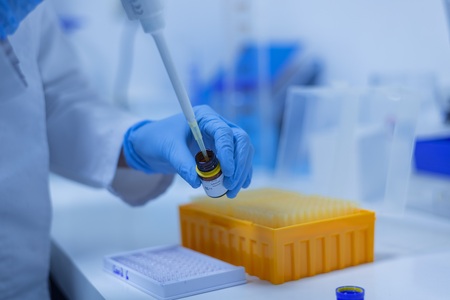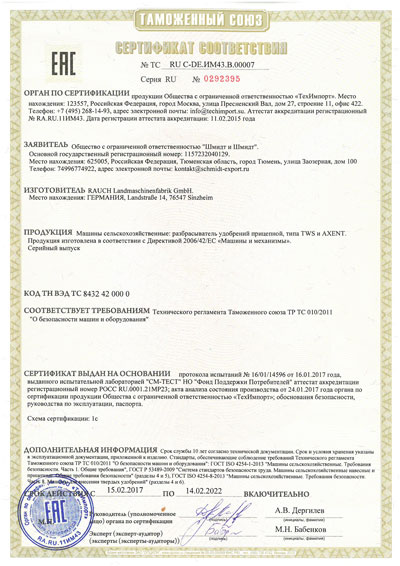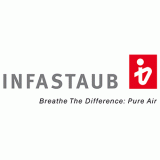
The market of the EAEU countries has long been gaining popularity among European manufacturers. In order to be allowed to sell the goods on the EAWU market, a number of mandatory conformity assessment procedures must be successfully completed.
One type of conformity assessment is the EAC certificate. In contrast to the EAC declaration it is drawn up by the accredited certification body on the analytical basis of the technical documentation and the test report provided by accredited test bodies, and possibly on the basis of an on-site manufacturing audit.
The procedure of conformity assessment is often a highly complex and time-consuming process, that raises many questions for manufacturers and importers. This article should help to find answers for these questions. All information provided in this article, bases on the Law № 184 of the Russian Federation "On Technical Regulation" of december 27, 2002 and on the GOST standard 31893-2012 Conformity assessment. Standard system in conformity assessment”.
Steps of the EAC certification process
Usually the EAC certification procedure consists in the following steps:
- Step: Application to an accredited certification body in the EAEU
- Step: Examination of the documents by the certification body and selection of the scheme of EAC certification
- Step: Classification of the products and selection of samples
- Step: Tests and examinations
- Step: Manufacturing audit (if provided by the Technical Regulation)
- Schritt: Issuance of the EAC certificate
- Schritt: Surveillance of the certified products (if required)
Application to an accredited certification body in the EAEU
Only a company with its registered office in the EAEU may apply for EAC certification. A foreign manufacturer is not authorized to apply for a conformity assessment in order to confirm the compliance of the products with the technical regulations.In order to be able to carry out EAC certification, the foreign manufacturer must appoint an authorized representative in one of the member states of the Eurasian Economic Union. This representative will then represent the interest of the foreign manufacturer in the cooperation with the certification bodies of the Eurasian Economic Union with regard to the safety and quality of the products and their compliance with the technical regulations.
The application for certification can be carried out according to different procedures, depending on if it is a single production or serial production.
Batch (intended for batch delivery): all of the specified quantity of manufactured units with the same name and designation as indicated in the Certificate of Conformity and intended for sale.
Product Unit: A single piece or quantity of product.
These and other definitions related to EAC Conformity Assessment are available in GOST 31894-2012 Terms and definitions in the field of conformity assessment (confirmation).
Selection of the scheme for EAC certification
All technical regulations contain descriptions of the EAC certification procedure, the so called schemes. The selection of the scheme, and thus the type of certification procedure, depends on the characteristics of the product, de production or rather the shipment. For the EAC certification, the scheme is determined by the certification body. The schemes of the conformity assessment represent the counterpart of the modules of the conformity assessment according to the EU guidline 768/2008/EG in the Eurasian Economic Union.
Schemes of EAC Certification
| Scheme | Product testing | Production audit | Inspection control | Scope of application | Certificate of conformity |
|---|---|---|---|---|---|
| 1C | Testing of product sample | Production audit | Testing of product sample and/or production audit | For mass production, applicant – domestic/foreign manufacturer with an authorized representative in the EAEU | EAC certificate for mass production |
| 2C | Testing of product sample | Quality management system certification | Testing of product sample and quality management system | Same as 1C | EAC certificate for mass production |
| 3C | Testing of product sample | - | - | For batch/single delivery, applicant – domestic/foreign seller (supplier) with an authorized representative in the EAEU | EAC certificate for batch/single delivery |
| 4C | Testing of each product | - | - | Same as 3C | EAC certificate for batch/single delivery |
| 5C | Assessment of the adequacy of the technical design of the product based on technical documentation | Production audit | Testing of product sample and/or quality management system | For mass production when conformity cannot be confirmed during product sample testing; applicant – domestic/foreign manufacturer with an authorized representative in the EAEU | EAC certificate for mass production |
| 6C | Assessment of the adequacy of the technical design of the product based on technical documentation | Quality management system certification | Same as 5C | Same as 5C | Same as 5C |
| 7C | Testing of a representative sample of the complete product (type sample) intended for production, or assessment of the adequacy of the technical design of the product based on technical documentation and additional evidence, testing of representative samples of one or more important parts of the product | Production audit | Testing of product sample and/or production audit | For machines/equipment intended for serial/mass production (with several variants); applicant – domestic/foreign manufacturer with an authorized representative in the EAEU | EAC certificate for mass production |
| 8C | Testing of a representative sample of the complete product (type sample) intended for production, or assessment of the adequacy of the technical design of the product based on technical documentation and additional evidence, testing of representative samples of one or more important parts of the product | Quality management system certification | Testing of product sample and/or quality management system | Same as 7C | Same as 7C |
| 9C | Conformity based on comprehensive quality assurance with design verification | - | - | For serial production supplied by a foreign manufacturer/for complex machines and equipment intended for enterprise installations in the EAEU; applicant – domestic/foreign manufacturer with an authorized representative in the EAEU | EAC certificate for mass production |
The certification body collects a number of documents submitted by the manufacturer or his authorized representative.
In order to carry out an EAC certification, samples and the following documents must be attached:
- application for certification
- detailed product description
- product denomination
- instruction manual in Russian
- technical drawing
- technical data sheet
In any case, a more detailed list of documents that can be found in the Technical Regulations, shall be indicated.
Selection of samples
After the examination of the submitted technical documentation, the certification body classifies the product and sends a decision on the application for certification to the applicant. In this decision the required quantity of samples is indicated. The number of samples can differ, depending on the product, the technical regulation and the value of the product (in some cases, the sample is destroyed during the tests).
It is easiest to send the samples as a postal item. Therefore some requirements must be met. More tips that can help the manufacturer select and ship samples can be found here.
Testing of the product sample

The testing of product samples is often a mandatory step in the EAC certification process. A representative sample of the product is tested for conformity with the requirements of the technical regulations of the EAEU. It is also examined whether the product is suitable for the intended use.
For EAC certification, only a certification body may transfer the samples to the laboratory for testing.
The sample tests are carried out in accordance with the standards specified in the Annex to the Technical Regulations (GOST standards) according to a special programme and methodology established on the basis of the generally accepted method of certification testing and depending on the type of product. The programme and methodology can be developed both by the manufacturer and by the experts of the certification body.
The results of the examinations are entered in the test report.
Manufacturing audit
For the EAC certification of some products, a manufacturing audit is provided by the technical regulations of the EAEU. This holds especially for EAC certification for serial production.
The audit is carried out by an accredited certification body on site. It primarily serves to verify whether the production processes comply with the specified requirements. The implementation of the production audit is regulated according to the national standard of the Russian Federation GOST-R 54293-2020 "Production audit for conformity assessment procedures".
Issuance of an EAC certificate

After the production audit is successfully passed, the certification body issues an EAC certificate and enters its number in the unified state register. As official forms are often in short supply, the process of issuing a certificate may be delayed.
The EAC certificate is valid from the date on which it is entered in the single register. The period of validity of EAC certificates for products depends on many parameters (for example the applied technical norm, the selected scheme and type of production: serial production, single shipment etc.), which are all specified in the technical regulations.
Inspection control
After the EAC certificate has been issued, regular checks must be carried out to ensure that the product continues to meet the technical requirements and that the products are properly marked with an EAC conformity mark. This takes the form of an inspection control on the part of the certification body that issued the EAC certificate.
Inspection control is a systematic, repetitive conformity assessment activity as a basis for maintaining the validity of the EAC certificate. The inspection control is only foreseen for EAC certificates. No external surveillance is required for EAC declarations.
The procedure of inspection control is described in GOST 58984-2020 "Conformity assessment. Procedure for inspection control in the certification procedure".
Suspension or revocation of the issued EAC certificates
The validity of the issued EAC certificate may be suspended temporarily or permanently in the following cases:
- The manufacturer and the applicant have mutually agreed to revoke the validity of the EAC certificate because production of the product has ceased
- A negative decision was issued after the inspection control
- Quality deficiencies were found during the inspection control, which have not been corrected by the applicant.
- The applicant has refused to carry out the inspection check or to pay for it, or has not had the inspection check carried out with the required frequency
- The production did not comply with the requirements of the technical regulations
- The technical regulations for products or the test methods, the product design, the composition of the products, the production management, the control and test methods, etc. have been changed and the corresponding certification bodies have not been informed about it
The EAC certificate can be suspended by the certification body for up to one month.
If the inspection control is not carried out in time or quality deficiencies have not been corrected after the control, the EAC certificate may be permanently revoked by the certification body.
The decision on suspending or revoking the conformity certificate is made by the certification body. It is also entered in the unified register. The applicant will be informed of the decision in writing within three working days.
The rights of the applicant
The applicant has the right to:
- select the forms and schemes of attestation of conformity for the goods specified in the technical regulations,
- to address itself to that certification body whose scope of accreditation applies to the declared goods,
- use the EAC conformity mark,
- to lodge complaints with the authorised body about unlawful acts by the certification bodies and centres (laboratories),
- as well as to apply to the court for the protection of their rights and legal interests.
Liability for Non-Compliance with Requirements
The sale of products without valid EAC conformity certificates or with falsified or unreliable documents entails severe penalties under Chapter 14 of the Law on Administrative Offenses. These may include fines of up to tens of thousands of euros, suspension of business activities, confiscation of products, and—in cases involving threats to life, health, or the environment—even criminal prosecution.
An overview of possible penalties for violations of EAC certification regulations can be found in our expert article. Therefore, it is of utmost importance to take the EAC conformity assessment seriously.
Authorized Representative for EAC Certification
Manufacturers that are not based in a member state of the Eurasian Economic Union (EAEU) are not allowed to independently apply for EAC certification of their products. Without a partner located in the EAEU, it is therefore impossible to obtain a valid EAC certificate.
In this case, the foreign manufacturer must appoint an authorized representative in an EAEU member state. This representative assumes legal responsibility and represents the manufacturer’s interests throughout the conformity assessment process. The authorized representative works with certification bodies and ensures that the products comply with the technical regulations and safety requirements of the EAEU.
Under current law, only a company located within the territory of the Eurasian Economic Union can be appointed as an authorized representative. For European, American, or Asian manufacturers, this is a mandatory requirement for certification and market access to the EAEU.
Schmidt & Schmidt supports manufacturers from Europe, America, and Asia in appointing an authorized representative in the EAEU. Thanks to our legally compliant solution concept via Kazakhstan – a member state of the EAEU – we can ensure the issuance of the EAC certificate. Through our local offices, we ensure that the entire certification process not only complies with the technical regulations of the Eurasian Economic Union but is also conducted in accordance with European and American sanctions regulations. In this way, our clients gain reliable and legal access to the EAEU market.
Compliance with EU and US sanctions in the context of EAC Certification

In addition to the technical regulations of the Eurasian Economic Union (EAEU), European and international companies must also comply with the applicable sanctions of the European Union and the United States when undergoing EAC certification. These regulations particularly concern the export of certain goods, trade with listed individuals and entities, and the provision of technical services. Non-compliance may not only jeopardize business relationships but also entail civil and criminal liability.
The situation is especially critical for exports to Russia and Belarus. Due to the geopolitical situation, numerous embargoes and restrictive measures have been imposed since 2014, which can directly affect the conformity assessment process. For example, it is possible that conformity assessment bodies or business partners in the affected countries are listed on sanctions lists, making cooperation legally impermissible. Therefore, companies must carefully review not only the technical regulations but also the current EU and US sanctions lists.
Another risk arises if a shipment is blocked due to sanctions violations. Even a formally correct conformity assessment does not provide legal certainty in such cases. Therefore, close coordination between compliance departments, export control officers, and certification partners is essential to avoid legal conflicts and to secure the supply chains.
Companies that aim to successfully export their objects of conformity assessment (products) to Kazakhstan, Russia, or other EAEU Member States should not focus solely on compliance with technical regulations but also ensure comprehensive sanctions compliance. This includes reviewing the end-use of products and selecting appropriate authorized representatives and local partners.
Schmidt & Schmidt provides a legally compliant solution via Kazakhstan. As an EAEU Member State, Kazakhstan is authorized to issue EAC certificates and EAC declarations. Through our local offices, we ensure that all conformity assessment processes are carried out in compliance with European and US sanctions regulations while enabling our clients to access the EAEU market.
Detailed information on current developments can be found in our article: EAC Certification Amid EU and US Sanctions against Russia and Belarus.
Validity of the EAC Certificate
The validity period of the EAC certificate depends on the respective Technical Regulation (TR CU/EAEU), the chosen certification scheme, and the type of delivery.
The validity is determined by the TR CU and the certification scheme. For serial deliveries, the certificate is usually issued for 1–5 years. In the case of single deliveries (contract-based), the certificate is valid only for the delivery or batch defined in the contract.
Single Delivery vs. Serial Delivery (Short Comparison)
| Criterion | Single Delivery (contract-based) | Serial Delivery |
|---|---|---|
| Validity | Only for the delivery defined in the contract | Fixed period, typically 1–5 years |
| Testing | Sample-based, depending on the product | Product/type testing according to TR CU, possibly recurring |
| Production Audit | Rarely required | Required by many TR CU (depending on the scheme) |
| Inspection Control | Usually not required | Annually to maintain validity |
| Suitable for | One-time/occasional deliveries | Ongoing/regular exports |
Notes for Manufacturers Outside the EAEU
For manufacturers without a registered office in the EAEU, the appointment of an Authorized Representative within the EAEU is a prerequisite to apply for and obtain the EAC Certificate or the EAC Declaration.
Costs of EAC Certification
The cost of an EAC certificate depends on various factors. A flat rate cannot be provided, as each product must be evaluated individually. The main criteria are:
- Type of conformity assessment: EAC Certificate or EAC Declaration
- Applicable regulation: relevant Technical Regulations (TR CU/EAEU)
- Type and complexity of products: design, number of components, variants
- Scope of testing: laboratory tests, safety and EMC verification, if applicable inspection control or manufacturing audit
- Completeness of documentation: technical documentation, drawings, test reports
- Type of delivery: single delivery (contract-based) or serial production
- Samples for testing: selection of representative models is crucial – proper selection and shipping of samples is part of cost planning
In order to accurately determine the certification costs, a technical evaluation of the product is necessary. For this purpose, we usually require a product description and the customs tariff number. Based on this information, you will receive an individual offer.
Detailed information can be found on our page Costs of EAC Certification and EAC Declaration.
How long does the EAC Certification process take?
The average processing time is usually several weeks, but it may vary depending on the complexity of the project.
The processing time depends on the following factors:
- Type of delivery: single delivery (contract-based) vs. serial delivery
- Product characteristics: complexity, number of components, and variants
- Scope of testing: required laboratory tests, safety and EMC verification
- Audit requirements: if applicable, manufacturing audit
- Completeness of documentation: technical documentation, drawings, test reports
- Available samples: selection and shipment of product samples for laboratory testing
Delivery of Documents
When ordering an EAC certificate, you will receive a copy of your certificate by email immediately after the successful completion of the certification process. The original will be sent to you by post within a few days.



















































